Grade 5 Gap Analysis - Science
1. Which is NOT a skill that scientists should possess?
They should be able to ____.
Correct Answer:
2. Which is NOT needed by all organisms for survival?
Correct Answer:
The picture below shows how a plant changes when it is touched. Use the information to answer question 3.

3. Which characteristic(s) of living things is/are shown by the plant?
Correct Answer:
A group of living things and non-living things is shown below. Use the information to answer question 4.

4. Which does NOT belong to each group?
Correct Answer:
The diagram below shows a river flowing into the sea. Use the diagram to answer question 5.
After looking at the picture a student stated that rivers are living things, because:
- larger rivers can form smaller rivers so they reproduce
- rivers move
- and rivers grow during floods

5. Is the student CORRECT?
Correct Answer:
The diagram below shows a flowering plant. Use the diagram to answer question 6.

6. What is the name of the structure labeled I?
Correct Answer:
Read the statement below and use it to answer question 7.
“This structure absorbs sunlight and uses it to make food for the plant.”
7. Which is the MAIN plant structure that carries out this function?
Correct Answer:
The diagram below shows a drawing of a root. Use it to answer question 8.

8. What is the type of root shown and in what type of plant is it found?
Correct Answer:
The two groups below show a set of invertebrates and a set of vertebrates. Use the information to answer question 9.

9. Which animals do NOT belong to the invertebrate and vertebrate groups?
Correct Answer:
The drawing below shows a flower. Look at the drawing and use it to answer question 10.

10. What is the function of the structure labeled I?
Correct Answer:
The drawings below show the results of a child’s investigation. Use the information to answer question 11.
A child carried out an investigation involving two similar plants. Both plants were placed in blue coloured water for 20 minutes. The drawings below show the results of the investigation.

11. What do the results of the investigation indicate?
Correct Answer:
The picture below shows a tool a student used to extend one of his senses. Use the picture to answer question 12.

12. Which sense was the child LIKELY trying to extend?
The sense of _____.
Correct Answer:
13. What is the function of the ear drum?
Correct Answer:
The diagram below shows the structure of the ear. Use it to answer question 14.
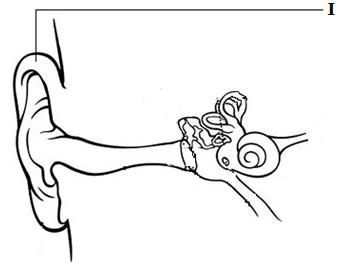
14. What is the name of the structure labelled I?
Correct Answer:
15. Which shows the route light takes from the eye to the brain?
Correct Answer:
The boxes below contain some information about bats. Use the information to answer question 16.
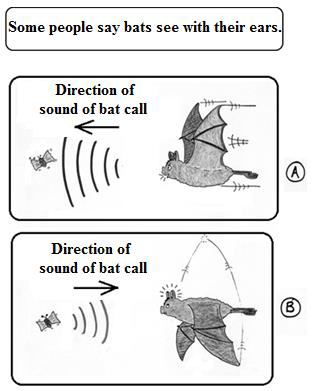
16. How does the bat use its senses to find its way to the insect?
The bat uses its _____.
Correct Answer:
Read the information in the box below and use it to answer question 17.
A child was able to press a piece of material into a different shape.
17. Which is TRUE about the material?
Correct Answer:
The table below shows 4 different materials and their uses. Use the information to answer questions 18 and 19.

18. Which set of materials are LIKELY to have similar properties?
Correct Answer:
19. Which is TRUE about material R?
Material R is _____.
Correct Answer:
The table below shows different materials and their characteristics. Use the information to answer question 20.

20. Which material is LIKELY a liquid?
Correct Answer:
21. Which are the MAIN components of air?
Correct Answer:
22. Which is a use of nitrogen?
Correct Answer:
23. Which is a property of water?
Correct Answer:
24. Which two are LIKELY sources of air pollution?
Correct Answer:
The diagram below shows the water cycle. Use the information to answer questions 25 and 26.
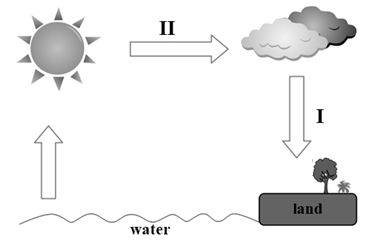
25. Which process takes place at the stage labelled I?
Correct Answer:
26. Which describes what happens at II?
Correct Answer:
The diagram below shows an observation a student made. Use the diagram to answer question 27.
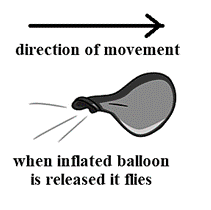
27. What property of air is shown by the observation?
The observation shows that ____.
Correct Answer:
Read the information below and then use it to answer question 28.
A man collected some water from a river. The water had small stones and other tiny material floating around. The man wanted to drink the water but was unsure if it was safe to drink.
28. Which would be the BEST method to make the water safe for drinking?
The man should _____.
Correct Answer:
The observation below was made by a child while viewing a river. Read the observation and use it to answer question 29.
The river contained solid waste like old tyres, plastics containers, old appliances and old furniture.
29. Which was a LIKELY source of the materials seen in the water?
Correct Answer:
The table below shows different community activities and how they contribute to air pollution. Use the information to answer question 30.

30. Which method would be MOST effective at reducing air-pollution in the community?
Correct Answer:
The box below contains some information on a town named Kent Hall. Use the information to answer question 31.
The town of Kent Hall once would receive rainfall every month of the year. Now, rainfall happens only a few months out of the year.
31. Which statement is CORRECT?
The _____.
Correct Answer:
A child wanted to make a tool to remove sediments from the water she gave her pet turtle. The diagram below shows her tool. Observe the tool and answer question 32.
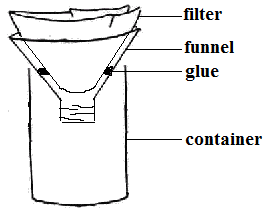
32. Which part of the tool had the function of removing the sediments from the water?
Correct Answer:
A farmer complained that the plants in his greenhouse did not grow very tall and many of them were dying. The picture below shows the farmer’s greenhouse. Use the picture to answer question 33.

33. Which feature of the greenhouse is LIKELY affecting the plants?
Correct Answer:
The box below contains some information about a child’s plan for an investigation. Use the information to answer question 34.
A child wanted to find out which of three rocks was the hardest. The test involved trying to scratch each rock with a twenty-dollar coin.
34. Which is a safety precaution that should be followed when carrying out the investigation?
Correct Answer:
The box below contains some information about a child’s plan for an investigation. Use the information to answer question 35.
A child wanted to find out if the air pressure in small balloons is greater than the air pressure in larger balloons. The child got three balloons of different sizes. The child then blew the same amount of air into each balloon. The child then used a pin to pop each balloon. The loudness of the pop was recorded.
35. Which is NOT a factor in the investigation?
Correct Answer:
The aim for an investigation is shown in the box below. Use the information to answer questions 36 and 37.
AIM: To see if water is needed for plant growth.
36. Which factor will NOT affect the results of the investigation?
Correct Answer:
37. What would make the investigation a fair test?
Correct Answer:
Read the information below and use it to answer questions 38 and 39.
A student had a sample of pipe water, river water and sea water. The student wanted to investigate which water sample would boil first.
38. Which is the BEST idea for the student to follow?
The three water samples should be _____.
Correct Answer:
39. Which table would be BEST for collecting the results?
Correct Answer:
The graph below shows the number of each type of vertebrates observed on a field trip. Use the information to answer question 40.
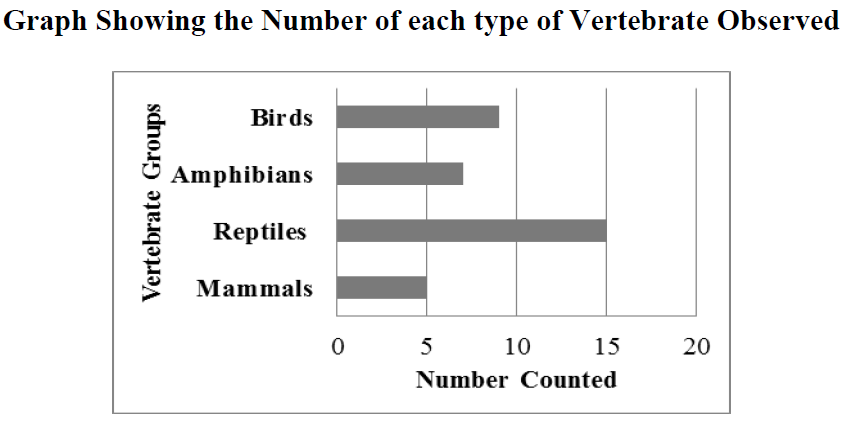
40. Which type of vertebrate was seen LEAST often?
Correct Answer:
The table below shows the results of an investigation. In the investigation different liquids were boiled. Use the information to answer questions 41 and 42.

41. Which liquid took the LONGEST time to boil?
Correct Answer:
42. Which liquid was pure water?
Correct Answer:
The table below shows the main sources of air pollution. Use the information to answer questions 43 and 44.

43. Which source produces the LOWEST amount of air pollution?
Correct Answer:
44. Which source would cause the GREATEST fall in air pollution if removed?
Correct Answer:
The diagram below shows the count of different materials seen polluting the Cape Cod River. Use the information to answer questions 45 and 46.
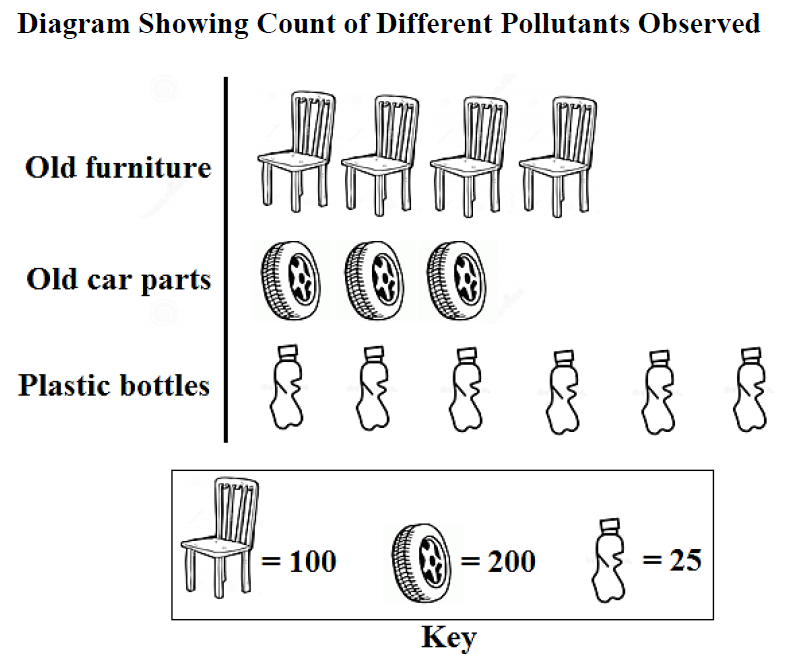
45. How many old car parts were seen in Cape Cod River?
Correct Answer:
46. Which statement is CORRECT?
Correct Answer:
The diagram below shows plant heights and plant pot sizes. Use the information to answer questions 47 and 48.
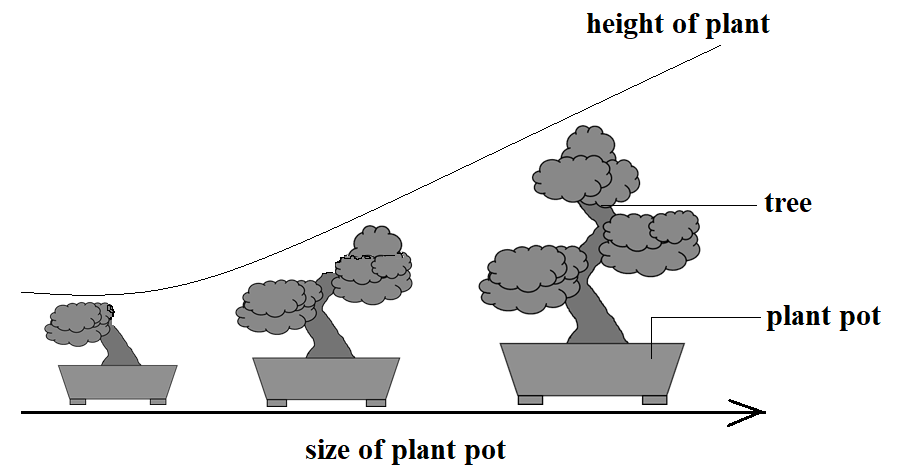
47. Which statement is TRUE?
Correct Answer:
48. Which table CORRECTLY shows the information seen in the diagram?
Correct Answer:
The information below shows a student’s notes from an investigation she did. Use the information to answer question 49.
Water Sample A started to boil at 45°C
Water Sample B started to boil at 100°C
Water Sample C started to boil at 25°C
And Water Sample D started to boil at 125°C
49. Which table below shows the information in the student’s notes?
Correct Answer:
The table below shows the observations made while visiting four rivers. Use the information to answer question 50.

50. Which statement is TRUE?
Correct Answer:
A student conducted a three day long investigation. The setup for the investigation is shown below. Use the information to answer question 51.
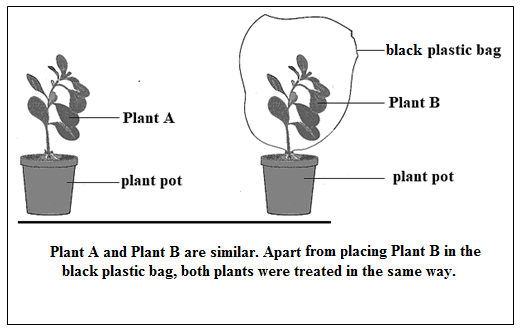
51. Which is most likely to occur?
Plant B _____.
Correct Answer:
Below is a description of an organism. Read the description and use it to answer question 52.
The organism was brightly coloured and hairless. It had thick, dry, scaly skin, and it was cold to the touch. It also had a backbone and lungs.
52. What type of animal was LIKELY observed?
Correct Answer:
The diagram below shows three glass tubes filled with water. The water in each tube had different amounts of oxygen. Each tube of water also contained small organisms. Look at the information below and use it to answer questions 53 and 54.
Each dot represents a tiny aquatic organism. These organisms float to the top of the water when they die.
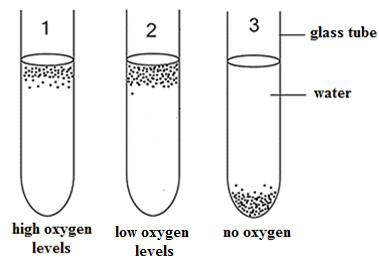
53. Which statement is likely true?
The _____.
Correct Answer:
54. Which location is BEST for the survival of the organism?
They need to live _____.
Correct Answer:
55. The table below shows the level of air pollution of three countries. Use the information to answer question 55.
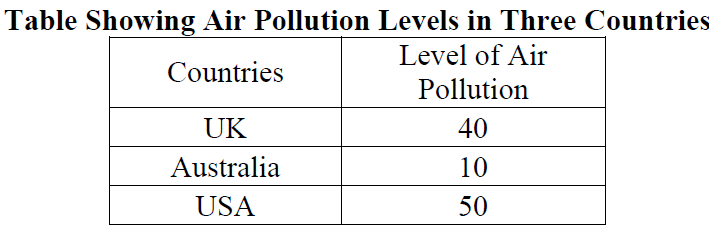
55. Which represents the information in the table?
Correct Answer:
Read the description of a river below and use the information to answer question 56.
The river was polluted by fruit and vegetable peels, plastic bags, empty juice and chemical bottles along with cardboard boxes.
56. What was the LIKELY source of the pollution?
Correct Answer:
The pictograph below shows the amount of water given to four similar plants. The pictograph also shows the height to which they grew. Use the information to answer question 57.
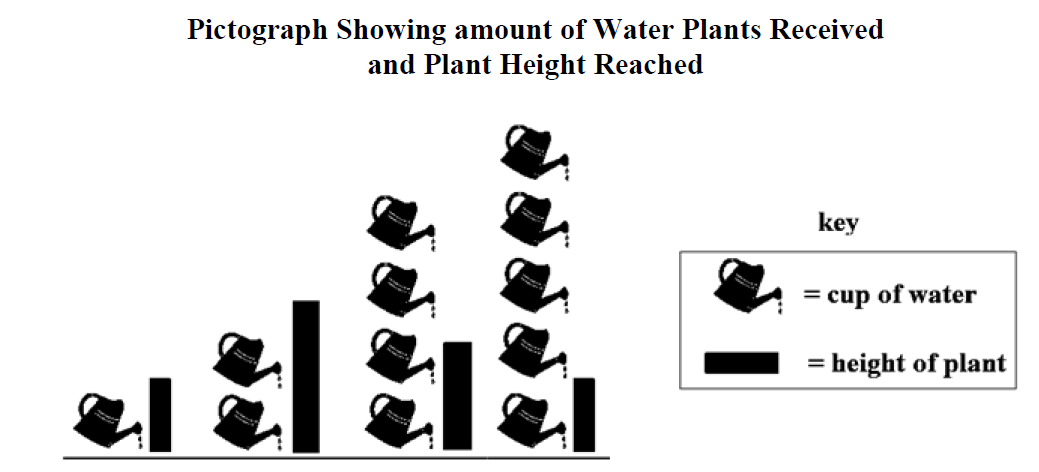
57. Which is a CORRECT conclusion that can be made from the pictograph?
Correct Answer:
The picture below was taken by a group of science students. The picture shows a polluted river. Look at the picture and use it to answer question 58.
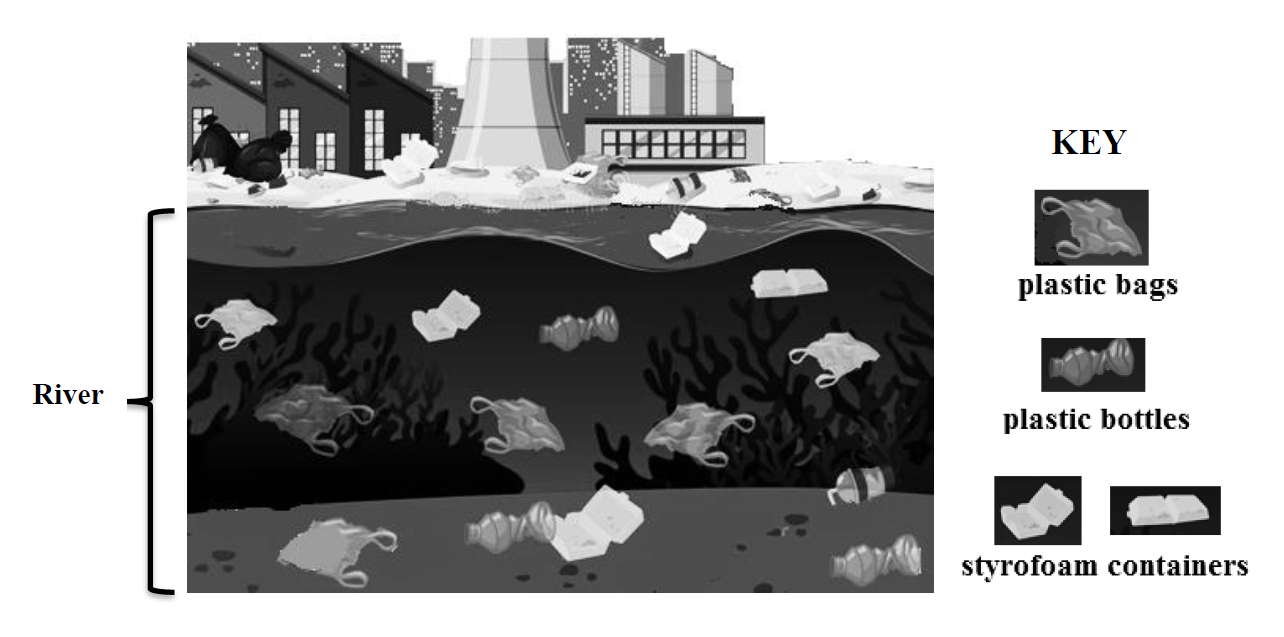
58. Which table CORRECTLY shows the number of different pollutants seen in the river?
Correct Answer:
A child tried to blow up identical balloons in two identical bottles. One of the bottles had a straw and the other bottle did not have a straw. The diagram below shows the results of the investigation. Use the information below to answer question 59.
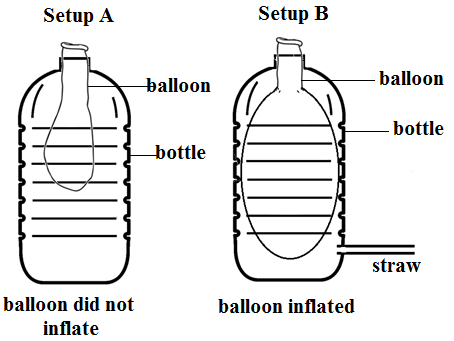
59. Which is a CORRECT conclusion based on the results of the investigation?
Correct Answer:
In the box below is a child’s prediction. Read the prediction and use it to answer question 60.
Prediction:
The plant will grow to a height less than 2 m if it receives more than 20g of fertilizer.
60. Which graph supports the child’s prediction?
Correct Answer: